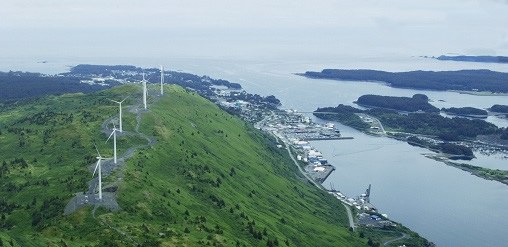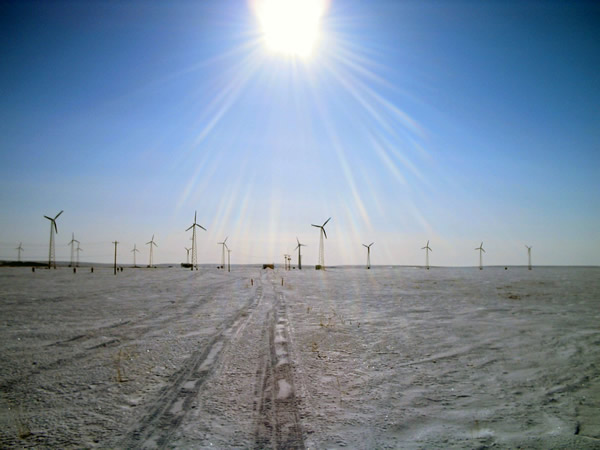 With its extreme weather conditions and isolated off-grid communities, Alaska is the American microgrid “frontier.” Over 200 remotely powered Alaskan villages are not connected to power grids. They are spread out over geographically varied regions with diverse energy resources, and have the highest energy costs in the US, sometimes up to 10 times the national average.
With its extreme weather conditions and isolated off-grid communities, Alaska is the American microgrid “frontier.” Over 200 remotely powered Alaskan villages are not connected to power grids. They are spread out over geographically varied regions with diverse energy resources, and have the highest energy costs in the US, sometimes up to 10 times the national average.
This makes Alaska the perfect place to experiment with the renewable integration of microgrids.
It’s no surprise that the state – one of the earliest adopters of microgrid technology – has now become a leader in the field, boasting 12% of the world’s hybrid microgrid systems, according to the Alaska Center for Energy and Power(ACEP) at the University of Alaska, Fairbanks.
In her welcome address to the 2017 HOMER International Microgrid Conference, Alaska Senator Lisa Murkowski said she has introduced a new energy bill in Congress. This bill would include funding a microgrid program at the Department of Energy to increase the use of microgrids, explore barriers to their deployment, and promote hybrid systems.
In this article we provide updates on some of the most successful hybrid microgrids in Alaska.
Alaska’s remote villages were originally exclusively diesel-powered. At an average price of $3.50 per gallon, diesel currently represents a significant cost to off-grid communities, and fuel delivery is often stymied by weather conditions and lack of road access.
Fortunately, Alaska has abundant renewable resources, with wind in the coastal and western areas of the state, hydropower in the southeast, and geothermal energy in many locations. During the past few decades, many Alaskan microgrids added wind to their diesel systems, and now they are beginning to diversify even further, incorporating battery storage, solar, and control technologies to manage the expanding range of generation resources. Public demand is to incorporate cleaner energy generation, and Alaska communities are also realizing that renewable energy can reduce electricity costs substantially.
HOMERⓇ Pro: An Essential Ingredient for Successful Microgrid Design
Identifying the feasibility of adding renewable generation and determining economically optimal resource combinations has been an ongoing mission for HOMER Energy in Alaska, according to a paper by John Glassmire, Director of Energy Engineering at HOMER Energy.
“From our experience,” says Glassmire, elaborating on Using Software to Make a Compelling Business Case for Mini-Grid Development, “we have learned how to overcome the challenges of using renewable energy to electrify communities. The technology to successfully deploy these hybrid renewable power systems exists today and has been proven in projects that have used our software to develop them—including more than 35 successful wind-diesel hybrid grids in Alaska.”
Now HOMER Pro is being used to model increasingly diverse Alaska microgrid systems that include batteries, flywheels, wind, diesel, and even solar.
HOMER Energy Partner ABB Leads Alaska Microgrid Development
Power engineering giant ABB is involved in dozens of microgrid projects throughout Alaska, particularly those that use energy storage, and the company has developed controls specifically to support remote communities. ABB is working on a variety of microgrids intended to provide cleaner, more reliable, and ultimately less costly electricity in Alaska, contributing expertise on batteries, flywheels, overall system design and digital controls. The controls are particularly important as microgrid systems diversify and become more complex, requiring instant responses to the intermittent input of renewable resources.
 Kodiak at 95% Renewable with Flywheels, Batteries
Kodiak at 95% Renewable with Flywheels, Batteries
Kodiak Island (pop. ~ 14,000) is an islanded microgrid with no connection to any other power system. Kodiak is the nation’s second largest island, at 3,600 square miles of land surface. The island is endowed with abundant hydropower resources, which supply about 76% of its electricity. To reduce diesel costs and pollution, the Kodiak Electric Association has deployed six 1.5 MW GE wind turbines that make up the Pillar Mountain Wind Farm, which provides the remaining 23% of the island’s power needs. The wind farm saves about two million gallons of diesel fuel annually at $3.50 per gallon, and the cost of wind is less than half the cost of diesel. With the help of Xtreme Power – now Younicos – Kodiak also installed a 3MW Battery Energy Storage System (BESS) that closes the gap between wind power and hydro when the wind stops suddenly.
Despite its relatively small population, Kodiak requires ample electricity to power several large fish processing plants and its busy port. One unique feature of the Kodiak microgrid system is ABB’s PowerStore flywheel energy storage system, which helps power the 340-foot, $10 million electric crane that services the port. While the crane lowers a heavy cargo container, gravity recharges the 2MW flywheels, and when it’s lifting, the crane draws on power stored in the flywheel system. That avoids drawing on the island’s electric grid to supply a power-hungry crane, since PowerStore can switch from a full-power charge to a full-power discharge in less than 5 milliseconds. The Kodiak flywheels also provide crucial stabilization to the electric grid, reacting instantly to smooth out power fluctuations caused by intermittent wind generation.
The Kodiak Electric Association still maintains several diesel generators on standby, but the utility says it uses them only during maintenance work on the hydropower facilities. Overall, Kodiak’s hybrid microgrid system has helped the island transition to cleaner, cheaper, and more reliable power since the days when diesel was shipped in on barges.
 Kotzebue Wind Diesel System Gets a Makeover
Kotzebue Wind Diesel System Gets a Makeover
The town of Kotzebue on Alaska’s central west coast is one of the state’s oldest wind-diesel systems, having installed the state’s first utility-grade wind turbines in 1997. By today’s standards the turbines were tiny at 60MW, and Kotzebue has now graduated to 900 MW machines, creating new challenges for the integration of intermittent renewable power. With a population of of 3,700 Kotzebue serves as a hub for surrounding communities, and now has 19 turbines with a capacity of almost 3MW. Although the cost of wind power is marginally higher for smaller systems, the components for really big machines can’t even be transported to most of Alaska’s remote communities, many of which – like Kotzebue – have no road access whatsoever. Nonetheless, wind power has successfully reduced diesel costs in many Alaska communities.
Located 30 miles above the Arctic Circle, Kotzebue is a great example of the extreme conditions Alaska residents must endure, and the energy challenges they face. Average annual temperatures are 22ºF and wind chill factors occasionally drive temperatures as low as -100º F! More importantly, the sun scarcely makes an appearance above the horizon during the winter months at all. But, that hasn’t stopped Kotzebue from making early investments in solar thermal systems, and the community plans to add more solar in 2018.
Kotzebue recently added a 1MW Saft containerized battery storage system, specially designed for extreme cold to its wind, diesel and solar resources. The batteries provide 950 kWh and can operate in temperatures as low as -58ºF. They help Kotzebue manage power fluctuations caused by its new wind resources, and store excess wind energy to reduce diesel consumption.
According to Rob Roys, ABB Western Regional Sales Manager and veteran Alaska microgrid developer, ABB is helping communities like Kotzebue optimize their generation and integrate distributed energy assets. As microgrids become more complex, smarter controls will enable the use of demand response, voltage regulation and other grid management tools that can facilitate an ever greater penetration of renewable resources. The ultimate goal, he says, is a grid that is flexible and adaptable to the inevitable evolution of energy technologies.
What’s Next for Remote Microgrids?
Important trends, according to Roys, include a move towards smaller, more distributed systems with a greater variety of resources. That in turn creates training challenges, and the need for buy-in and engagement in remote communities. Another interesting development that has paralleled the evolution of microgrids as well as ABB technology, is control platforms that are based on peer to peer networks, reflecting the distributed nature of microgrid assets. A final trend is enabling a microgrid with modern communications technologies that provide the ability to not only monitor, but maintain and optimize the system remotely. Alaska is aiming at 40% renewable energy penetration by 2035. Judging from current accomplishments, continuing diversification of generation resources and microgrid innovation, they are well on track to reach that goal.

Great article about a frontier state in renewable-powered micro-grids. XANT will be deploying 2 of its XANT M ETR (extreme temperature range) in Alaska this winter. Looking forward to be part of this challenge.
Thanks Alex. Good luck with your upcoming project and let us know how it goes.
I was in Alaska working for Robert W. Retherford Associates back in 1972/73 when the Terror Lake project was being developed. I left to go to work with GE at the Manned Spacecraft Center in Texas and only found out about the fine work done on Kodiak when I visited in 2013 and inquired about the project. I eventually worked for Dow Chemical in Power Generation before retiring in 2008. My old boss Bob Retherford was way ahead of his time in thinking about microgrids and unique applications in Alaska and I used what I learned in Alaska throughout my working career. Keep up the good work Homer.
Thanks so much for the comment Elo. Congratulations on being part of these pioneering energy projects in Alaska and interesting that your work took you from Kodiak to outer space!
Perhaps Cordova will be in this list soon – great article
Thank you for reading Clay! We are always looking for good microgrid stories, so please keep us in mind. I sent you an email.
All the best, Lili